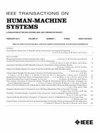通过投射式增强现实和大脑接口支持人机交互
IF 4.4
3区 计算机科学
Q2 COMPUTER SCIENCE, ARTIFICIAL INTELLIGENCE
引用次数: 0
摘要
本文介绍了一种与增强现实(AR)系统相结合的脑机接口(BCI),用于支持人机交互,控制机械臂完成拾放任务。脑机接口可以处理稳态视觉诱发电位(SSVEPs),这是通过视觉刺激产生的信号。视觉刺激可通过 AR 系统传达给用户,从而扩大了可能的应用范围。所提出的方法充分利用了 NextMind BCI 的功能,使用户能够选择机械臂范围内的物体。通过投射 AR 显示与场景中每个物体相关的视觉锚点,NextMind 设备可以检测用户何时将视线集中在其中一个物体上,从而触发机械臂的拾取动作。该系统的设计考虑到了行动不便者的需求和局限性,以支持他们控制机械臂完成拾放任务。系统提出并分析了两种不同的视觉锚定位方法。用户参与的实验测试表明,这两种方法都受到了高度评价。系统性能非常稳定,因此用户可以轻松、快速、可靠地选择对象。本文章由计算机程序翻译,如有差异,请以英文原文为准。
Supporting Human–Robot Interaction by Projected Augmented Reality and a Brain Interface
This article presents a brain–computer interface (BCI) coupled with an augmented reality (AR) system to support human–robot interaction in controlling a robotic arm for pick-and-place tasks. BCIs can process steady-state visual evoked potentials (SSVEPs), which are signals generated through visual stimuli. The visual stimuli may be conveyed to the user with AR systems, expanding the range of possible applications. The proposed approach leverages the capabilities of the NextMind BCI to enable users to select objects in the range of the robotic arm. By displaying a visual anchor associated with each object in the scene with projected AR, the NextMind device can detect when users focus their eyesight on one of them, thus triggering the pick-up action of the robotic arm. The proposed system has been designed considering the needs and limitations of mobility-impaired people to support them when controlling a robotic arm for pick-and-place tasks. Two different approaches for positioning the visual anchors are proposed and analyzed. Experimental tests involving users show that both approaches are highly appreciated. The system performances are extremely robust, thus allowing the users to select objects in an easy, fast, and reliable way.
求助全文
通过发布文献求助,成功后即可免费获取论文全文。
去求助
来源期刊

IEEE Transactions on Human-Machine Systems
COMPUTER SCIENCE, ARTIFICIAL INTELLIGENCE-COMPUTER SCIENCE, CYBERNETICS
CiteScore
7.10
自引率
11.10%
发文量
136
期刊介绍:
The scope of the IEEE Transactions on Human-Machine Systems includes the fields of human machine systems. It covers human systems and human organizational interactions including cognitive ergonomics, system test and evaluation, and human information processing concerns in systems and organizations.
 求助内容:
求助内容: 应助结果提醒方式:
应助结果提醒方式:


